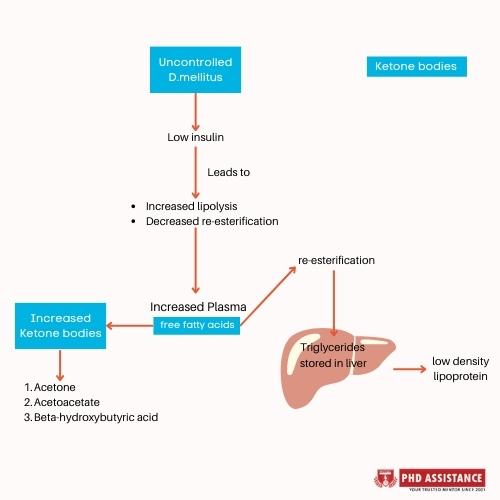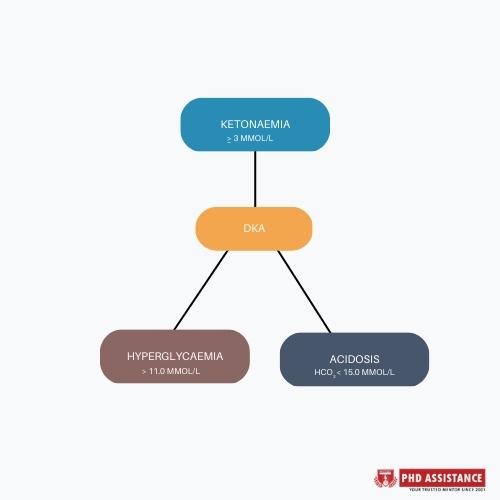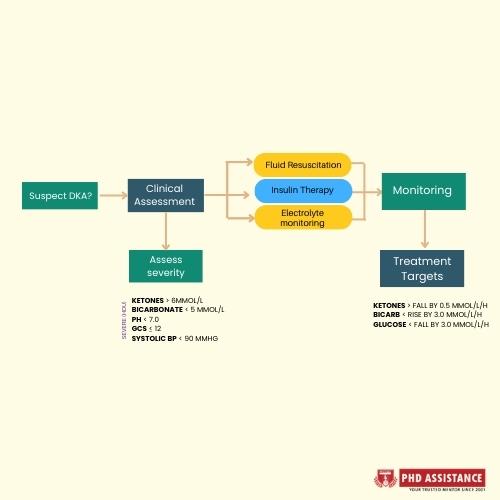What Are The Clinical And Biochemical Findings In Diabetic Ketoacidosis Conditions In Research?
Critical cause of Diabetic ketoacidosis (DKA)
Diabetic ketoacidosis (DKA) occurs when the signaling from the body’s insulin is so inadequate that it causes the following conditions:
- Blood sugar cannot enter cells that may be utilised as an energy source.
- The hepatic tissue makes up a remarkable quantity of blood sugar.
- The body cannot keep up with the rate at which fat is broken up.
The hepatic system is responsible for converting fats into a resource known as ketones. The hepatic cell generally creates ketones if the body breaks down fat during fasting. Ketone bodies are generally utilised by muscle tissue and the cardiac system. Ketones can be lethal since they make the blood additional acidic if generated excessively and allowed to accumulate in the bloodstream. The condition is developed called Ketoacidosis (Chung, J. Y., 2022).

Clinical outcomes of Diabetic ketoacidosis (DKA) patients
Typical symptoms of DKA include excessive thirst (also known as polydipsia) and frequency of urination. These classic indications could be exacerbated by more systemic manifestations such as fatigue, sickness, vomiting, and abdominal discomfort. When DKA advances, patients have to worsen systemic symptoms, including dehydration and disorientation. Kussmaul’s breathing, often known as deep sighing, is a typical sign of DKA, and Ketotic breath is another symptom with a sweet pear drop smell.

Biochemical parameters related to the Diabetic ketoacidosis (DKA) condition
Determining the medical biochemistry combination of hyperglycemia, acidaemia, and ketonaemia/ketonuria is the basis for diagnosing DKA—urgent diagnostic procedures to establish confirmation of DKA (Choo, S. J., 2022).
- Blood glucose level: > 11.0 mmol/L
- Venous/arterial blood gas: pH < 7.3 or bicarbonate < 15 mmol/L
- The presence of ketone bodies is capillary blood ketone ≥ 3 mmol/L or urinary ketones +++ or above.

Among the adult population, the prevalence of diabetic ketoacidosis treatment is highest among those aged 20 to 40 years. Males, compared to females, have diabetic ketoacidosis at a higher incidence. Compared with type 2 diabetics, those with type 1 diabetes have a higher risk of developing DKA. There is no connection between the length of time someone has diabetes and the risk of developing diabetic ketoacidosis symptoms. The most prevalent presentations found in this research are thirst, frequent urination leading to dehydration, intellectual disorientation, and sickness or vomiting. Infections, insufficient insulin delivery, and the absence of insulin or other drugs are the triggering variables seen more often.
The HbA1c level has a significant, meaningful link with the occurrence of DKA. Patients who appear with cognitive disorientation or coma have an increased serum osmotic pressure level, which has a significant association with these symptoms. Patients with decreased plasma bicarbonate levels tend to have more extended hospital stays. There is a substantial correlation between the two. There is no connection between a patient’s HbA1c level and the length of their hospitalisation. However, according to literature reviewed, it would be better to check clinical symptoms with biochemical tests in DKA frequently.
At Ph.D. Assistance’s, Ph.D. dissertation writing services are completely managed and written in compliance with the institutional criteria involving style, design, and structure of an ideal dissertation. We help you at every step, whether it’s dissertation topic selection or the research proposal assistance for the topic you’ve chosen to research, or medical dissertation content development.
References
Almazrouei, R., Afandi, B., AlKindi, F., Govender, R., & Al-Shamsi, S. (2023). Clinical Characteristics and Outcomes of Diabetic Ketoacidosis in Patients with Type 2 Diabetes using SGLT2 Inhibitors, Clinical Medicine Insights: Endocrinology and Diabetes, 16, 11795514231153717.
Choo, S. J., Lee, H. G., Kim, C. J., & Yang, E. M. (2022). Severe hypernatremia in soft drink ketoacidosis and hyperglycemic hyperosmolar state at the onset of type 2 diabetes mellitus: a case series of three adolescents. Clinical Pediatric Endocrinology, 31(2), 81-86.
Chung, J. Y., Kim, O. Y., & Song, J. (2022). Role of ketone bodies in diabetes-induced dementia: sirtuins, insulin resistance, synaptic plasticity, mitochondrial dysfunction, and neurotransmitter. Nutrition reviews, 80(4), 774-785.
Farooq, U., Tarar, Z. I., Kamal, F., Malik, A., Bresnahan, J., & Abegunde, A. T. (2022). Is acid suppression associated with the increased length of stay in diabetic ketoacidosis patients? A nationwide analysis. Journal of Internal Medicine, 292(1), 136-145.



